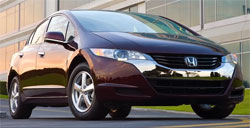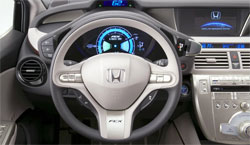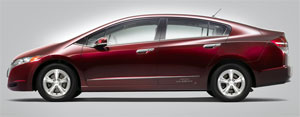2008 Honda FCX Clarity
Automotive technology is constantly evolving, and one company that strives to stay at the forefront is Honda. So we weren’t surprised by the release, for public consumption, of their very forward-thinking FCX Clarity hydrogen fuel-cell car. Now this high-tech machine clearly looks ready for the Jetsons. But, with all its advancement, is this Clarity, really clear thinking for today?
Because of issues involving cost, durability, and infrastructure, the future of hydrogen fuel-cell power as a practical automotive power source hangs in the balance. But Honda seems confident that this zero-emissions technology is the answer to sustainable transportation. So, enter the new 2008 FCX Clarity sedan.
This overtly futuristic four-door is the highly-anticipated limited-production version of the new generation FCX unveiled in concept form at the 2006 Los Angeles Auto Show.
 The Clarity’s advanced Honda V-Flow platform utilizes a compact and lightweight fuel-cell stack that is located in the center tunnel. It’s 20% smaller and 30% lighter than the stack in the last FCX, and it is now mounted vertically rather than horizontally. Honda says this enhances the flow of hydrogen and water for higher efficiency. We say it also allows a lower floor, freeing up more passenger room.
The Clarity’s advanced Honda V-Flow platform utilizes a compact and lightweight fuel-cell stack that is located in the center tunnel. It’s 20% smaller and 30% lighter than the stack in the last FCX, and it is now mounted vertically rather than horizontally. Honda says this enhances the flow of hydrogen and water for higher efficiency. We say it also allows a lower floor, freeing up more passenger room.
Its operation remains typical for a fuel-cell, containing stored hydrogen with oxygen for a chemical reaction that outputs 100 kilowatts of electricity to power the vehicle’s electric drive. And the only emission from this process is water vapor.
In addition, a high capacity lithium-ion battery supplements power during start-up and acceleration.
Both energy sources feed an AC synchronous motor that moves the Clarity briskly and with just a flutter of sound. Think of a hopped-up golf cart. Output is rated 134 horsepower and an almost instantaneous 189 pound-feet of torque. Top speed is 100 miles-per-hour.
The motor is combined with a new coaxial gearbox which feeds the Clarity’s front wheels.
In terms of efficiency, Honda claims fuel economy equivalent to about 68 miles-per-gallon. That’s more than double the mileage of a Honda Civic, and about 50% better than the hybrid Toyota Prius. A full tank of compressed hydrogen gives the vehicle a cruising range of 270 miles.
The Clarity’s rigid chassis mirrors other Honda sedans, a double-wishbone suspension up front, and a multi-link double-wishbone at the rear. The result is a smooth and compliant ride with acceptable handling dynamics, furthered by responsive electric power steering.
The FCX Clarity also integrates Traction Control and Vehicle Stability Assist to assure more confidence during harsher driving conditions. Adaptive Cruise Control also comes standard, and improved regenerative braking system does a better job of controlling downhill acceleration, and thus reducing the need for frequent braking.
Honda learned from the Toyota Prius that public awareness of a futuristic powertrain, benefits from futuristic styling.
The flying saucer-like styling of this techno-marvel speaks of nothing less than a sci-fi runabout. Up front is a snubbed nose, banded headlamps, and mouth-like grille that creates a robot-like persona.
The Clarity’s long, sweeping lines move toward a thick-set back-end. Overall length is mid-size at 190.3 inches.
Down below, you’ll find ultra-lightweight forged-aluminum 5-spoke wheels.
The taillights and rear sculpting are the cappers on this deliberate spaceship design, and the trunk lid includes a small glass panel to aid rearward visibility.
 Inside, the spacious four-seater cabin is headlined by a deep disc-shape instrument panel. Controls are clean and very “tomorrow.” There’s a digital speed readout, and a prominently featured, high-tech fuel consumption display.
Inside, the spacious four-seater cabin is headlined by a deep disc-shape instrument panel. Controls are clean and very “tomorrow.” There’s a digital speed readout, and a prominently featured, high-tech fuel consumption display.
To stay with the ‘green’ theme, seats are covered with upholstery made from Honda’s plant-based bio fabric.
But there are also plenty of creature comforts, such as steering wheel controls, dual-zone climate, back-up camera, and navigation.
There’s also a plethora of storage compartments throughout the interior, and safety comes from six standard airbags.
The rear seat has ample room for two with a center console and cup holders.
The Clarity’s trunk is a usable 13.1 cubic feet including an under-floor storage compartment.
Now, for the downer - you won’t be able to buy an FCX Clarity anytime soon. Even if you could, hydrogen fueling stations are few and far between.
But, to gain real-world experience, starting this summer Honda will lease the Clarity to a limited number of consumers in Southern California. The three-year term will carry a price of $600 a month, including maintenance and collision insurance.
Hydrogen fuel-cells could very well become the wave of the future. But making hydrogen readily available is still problematic. One hope is for practical home hydrogen generating stations, transformed from natural gas. But until that issue is resolved, the full promise of the automotive fuel cell will remain clouded. Still, Honda is clearly focused on being ready for that greener road with the 2008 FCX Clarity.
Specifications
- Engine: V-flow Platform With Lightweight Hydrogen Fuel-cell Stack
- Horsepower: 134
- Torque: 189 Lb Feet
- Fuel Economy: 68 MPG
- Cruising Range: 270 Miles






